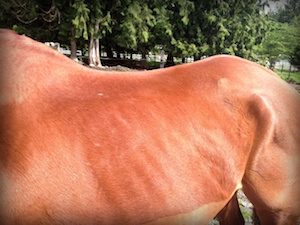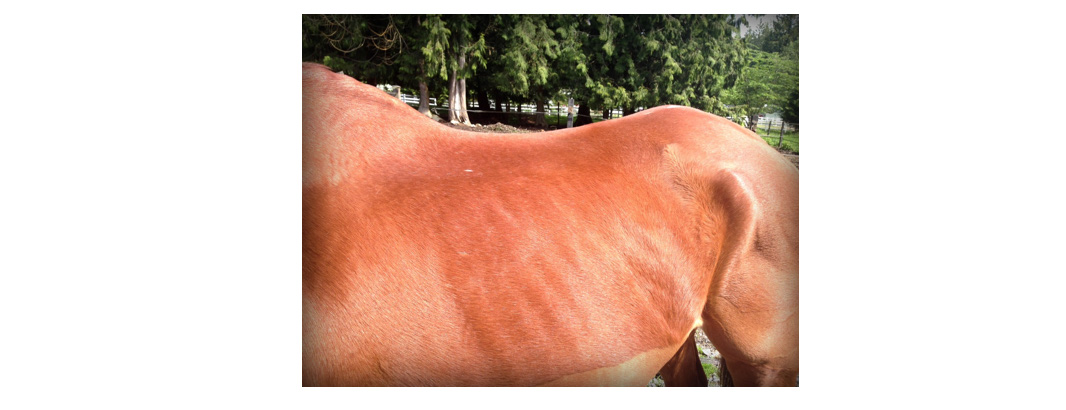Identifying and Correcting Poor Muscle Development
by Gina Fresquez, MS, CHHC

Now that show and competition season is in full swing you may be noticing your horse’s condition and whether it needs improving or you need to make adjustments to keep your horse strong and with a competitive edge. This time of year I hear from many horse owners who struggle with developing muscle and a strong topline at their horse’s peak performance.
How do you identify a weak or poor topline? The topline is the area of the horse’s back right behind the cantle of the saddle, above the hips. A poor topline is noticeable when you can either see and/or feel the back bone of the horse and the muscle around these areas slopes down creating a ridge instead of feeling flat. There could be many reasons why the horse is having trouble developing a strong topline. These include incorrect exercise, back problems, improper collection, poor fitting tack and certain diseases. They should all be addressed with your veterinarian, but from a nutritional view there are some important things to consider:
First, is your horse on a nutritionally balanced diet? There are many vitamins and minerals that have big roles in muscle function and development, like selenium, magnesium, zinc, vitamins E, B6, and C. However, don’t just single them out, it is more important to focus on balancing the WHOLE diet rather than on one specific nutrient so that the horse’s systems can work together. A “nutritionally balanced diet” means that you are feeding a feed and/or supplement that is designed to fully fortify the horse’s vitamin, mineral and protein needs when fed as directed. The problem that I see too often is that a horse owner will have the best of intentions with feeding a good quality feed or supplement, but only feeds a fraction of the recommended dose. This is actually not doing your horse any good; it is a waste of money. It is like only taking half of your one-a-day vitamin. If you find your horse having a weak or poor topline and you are not feeding a balanced diet OR you are feeding less than what is recommended, I suggest you start there.
Second, is your horse getting enough protein? Protein has gotten a bad reputation over the years and is often misunderstood with horse owners. I come across people who love it, hate it, and people who are scared of it. Regardless, the reality is your horse needs it! Protein is one of the main essential nutrient groups for your horse and is actually needed in larger amounts to fulfill an athletic horse’s needs (for example, according to the NRC, a moderately working athletic horse needs approximately 768 grams of protein a day). Protein is also important as it improves muscle growth and strength, increases stamina, aids in hoof quality and mane and tail growth, just to name a few.
Additionally, is your horse getting quality amino acids? Amino acids are the building blocks that make up protein structure and although there are 21 needed by the horse in some fashion, we generally pay attention to the most limiting ones: lysine, methionine and threonine, for starters. Not all protein sources are created equal as some contain more of the essential amino acids needed by the horse than others. For example, alfalfa, though high in crude protein, only contains about 0.75% lysine, whereas soybean meal contains about 2.5% lysine. If your horse is not getting these essential amino acids provided by the diet, then no amount of exercising, hard work, climbing hills, etc. will lay down the proper muscle for improved topline. These amino acids must be consumed by the horse to replenish the muscles after a hard workout or else you will continue to see deterioration. It is very similar to human body builders who drink their protein shake after their workout so that they can continue to repair and build muscle bigger than before. If you are working your horse on a physical level to improve back and topline strength and you are seeing limited results, it is a sign you might need to adjust the quality of the protein in his diet. This can most easily be done by feeding the horse a good quality concentrate or supplement that includes most or all of the limiting essential amino acids.
The topline of the horse is one of toughest places to build muscle and fill out. Therefore, it is important to pay attention to your horse, make the essential changes with diet and exercise and give the horse at least 60 days on the new regimen to see results.
Originally Published August 2014 Issue
Gina Fresquez, MS, is a lifelong horse enthusiast with a passion for helping horse owners make sense of equine nutrition. She received her BS in equine science and Master’s degree in equine nutrition from the University of Arizona and has worked as a technical equine specialist for Purina Animal Nutrition since 2006. Gina works closely with horse owners, stables and veterinarians determining feed rations, testing hay, and addressing nutritional related challenges in the Pacific Northwest.
Contact Gina and find out more information: www.horse.purinamills.com.
Cell: (206) 743-6453
Email: gmfresquez@landolakes.com

